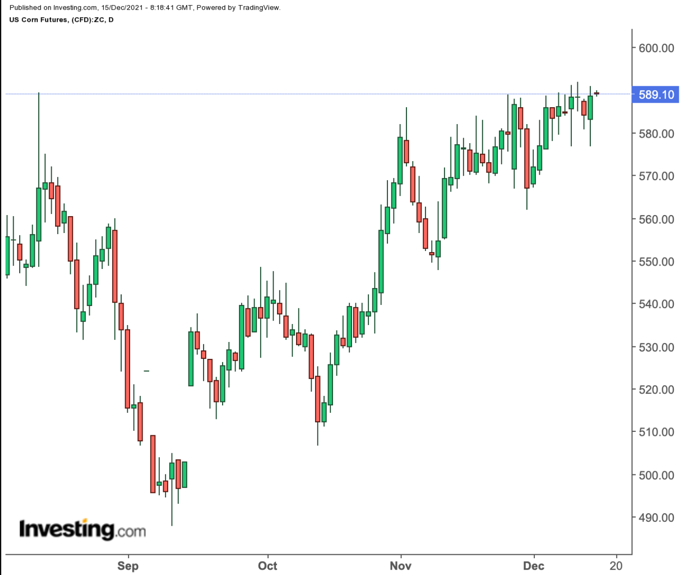The grains race looks like a photo finish to the close between two of its three contenders. 
Both corn and wheat are up more than 21% for the year in a neck-and-neck race for the grains crown for 2021.
Conspicuously missing from the race is soybeans, the third major component of the agricultural market, which is down more than 4% on the year.
The paths taken by wheat and corn to reach the pinnacle of the ags space couldn’t have been more different.
Wheat had an unbroken seven-month rally from the end of May, and two other months of gains through the year amid a production squeeze in the commodity used for making staples from bread to pasta and cereal.
Corn’s gains, in contrast, were scattered over eight months of the year.
With two weeks before the year-end, either one of the commodities could take a definitive lead. However, at this point, neither appear to be experiencing a slowdown in the demand that has taken them to where they are.
And both are supported by the tensions revolving around Ukraine and Russia—the third largest producer of wheat.
Wheat is “higher… as geopolitical tensions fill the air,” said Jack Scoville, chief crop analyst at Chicago’s Price Futures Group. “The market is talking about the buildup of Russian troops along the Ukraine border and fears a war will break out,” added Scoville.
“A war between these two countries could have severe repercussions for the world wheat trade as both are big producers and exporters.”
Scoville said there were also ideas that the United States, the fourth largest wheat producer, will see strong demand for this year as the rest of the northern hemisphere was short on production.
“So far, US demand has been average against previous years,” said Scoville.
“Offer volumes are down from both Russia and Europe although there has been talk of increased offers from Russia.
“Dry weather in southern Russia as well as the northern US Great Plains and Canadian Prairies caused a lot less production and are also supporting the market. The lack of (global) production has reduced the offers and Russia plans to announce sales quotas for next year very soon. Russia has already increased export taxes to control the flow of export wheat out of the country.”
As for Australia, its wheat quality appeared to suffer from too much rain, although conditions there are drier now and the sixth largest grower is moving ahead with its harvest.
“These international moves should increase demand for US wheat,” Scoville said, forecasting a resistance of between $7.11 and $7.51 for a bushel of Chicago-traded wheat versus support stacked at $7.68 first, $7.58 next, and $7.51 last.
US wheat futures hit a nine-year high of $8.63 in November and currently trade at around $7.76.
In corn’s case, supplies were also relatively tight in the US, the No. 1 producer, with farmers mostly done harvesting and not selling.
“Demand has been good so far this season but a lot of business has gone to Ukraine this fall,” said Scoville, adding:
“That is expected to change over the winter as Ukraine’s exportable supplies start to run low. It could change further if Russia invades Ukraine in the future.”
Price Futures has forecast resistance for US corn at $5.90, $5.94, and $5.97 per bushel versus support at $5.82, $5.76, and $5.72.
US corn futures hit 10-year highs of $7.75 in May and currently trade under $5.90.
Disclaimer: Barani Krishnan uses a range of views outside his own to bring diversity to his analysis of any market. For neutrality, he sometimes presents contrarian views and market variables. He does not hold a position in the commodities and securities he writes about.
